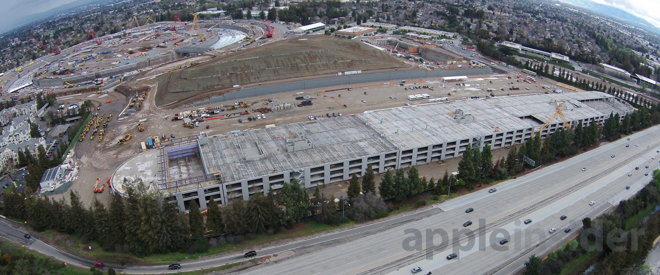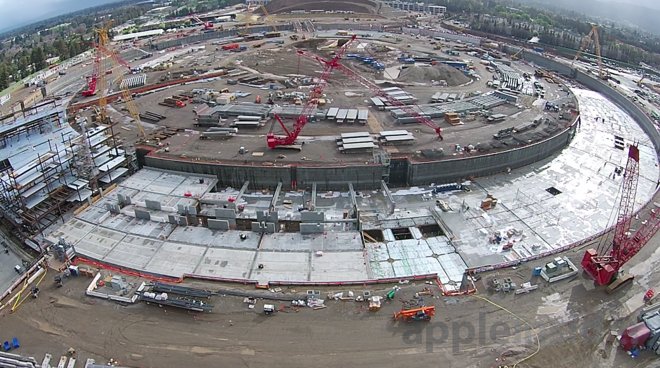Apple's Campus 2 mega-project is showing major progress in its "Spaceship" Ring, where interlocking concrete slabs are building a foundation for a steel structure that is already beginning to reach upward by four stories. The first massive parking garage is nearly finished and existing buildings have been demolished to make room for a second stage R&D site.

Apple Campus 2 in February 2015, viewed from the south
In just over a month since we last examined the site's progress in late December, work on Apple Campus 2 has maintained its aggressive schedule. Concrete slabs cover the base floor of the Ring, which will apparently accommodate additional underground parking.

Apple Campus 2 Ring from the north
The Ring connects to a tunnel structure that will replace Pruneridge Avenue, which formerly crossed through the site. The new underground roadway will also route vehicles toward two above ground, four storey parking structures, the first of which is nearly complete apart from a top decking of solar panels--despite being just bare earth back in September and only beginning to rise in October.
Making room for new R&D buildings along N Tantau Avenue
Apple began demolishing the former Hewlett Packard Pruneridge Campus buildings in 2013, but within just the last month it has also removed Ridgeview Court 1, a two-building complex Apple had been using as office space, located south of the HP site (below Pruneridge) on land Apple had previously acquired before the HP site became available.
In December, AppleInsider exclusively reported on the removal of an adjacent Ring prototype building we first detailed in October. Both structures are still depicted in Apple Maps' current Flyover models (below top), but they are now empty lots (below bottom, today).
The company continues to operate eight office groups on the east side of N Tantau Ave (which is the eastern boundary of the Campus 2 site), along with at least four other office blocks between E Homestead Road (the north boundary of Campus 2) and Stevens Creek Blvd, not including two other large office sites on Vallco Parkway, which is located south of the 280 freeway (the south boundary of Campus 2). All of these buildings are within Cupertino, just west of the boundary of the adjacent city of Santa Clara.
Auditorium complex taking shape
Just north of newly demolished Ridgeview Court 1 site, Apple's underground theater is now taking form, with a circular structure being built within the north section of the large excavated hole. Construction permits indicate that the auditorium complex will cost around $161 million to complete.
Campus 2 February 2015 Theater
The theater site will include a 120,000 sq ft "assembly space" with seating for 1,000, kitchen facilities and a large lobby area. In September, the theater excavation was a shallow pit (below), just south of Ridgeview Court 3, which is the last major building within the site that has not yet been demolished.
Expected occupation by the end of next year
Granted final approval just over one year ago, Apple's Campus 2 project is rapidly moving toward its occupancy goal of 2016.
Apple's cofounder Steve Jobs unveiled the huge project in 2011, noting that the central 2.8-million-square-foot "Spaceship" structure would house at least 12,000 employees, surrounded by bucolic landscaping including orchards of fruit trees and other greenery, featuring open space and walking paths to reclaim most of the 150-acre plot previously covered by asphalt parking lots.
See previous coverage on AppleInsider of Apple Campus 2 and the current Infinite Loop headquarters, or our other articles on drones. Viewers interested in the DJI Phantom 2 Vision+ can read more about the device or pick one up here.
Note: Readers should be aware that Apple's Campus 2 site is extremely hazardous to photograph using an aerial drone, in part because the site is so large it is nearly impossible to fly over even one quarter of the site within constant visual or radio contact using a consumer drone, and in part because the site is partially within an FAA restricted zone because of the nearby San Jose International Airport. There is constant traffic of low flying aircraft over the site. We strongly encourage inexperienced aerial drone pilots not to attempt to fly in or around the site.